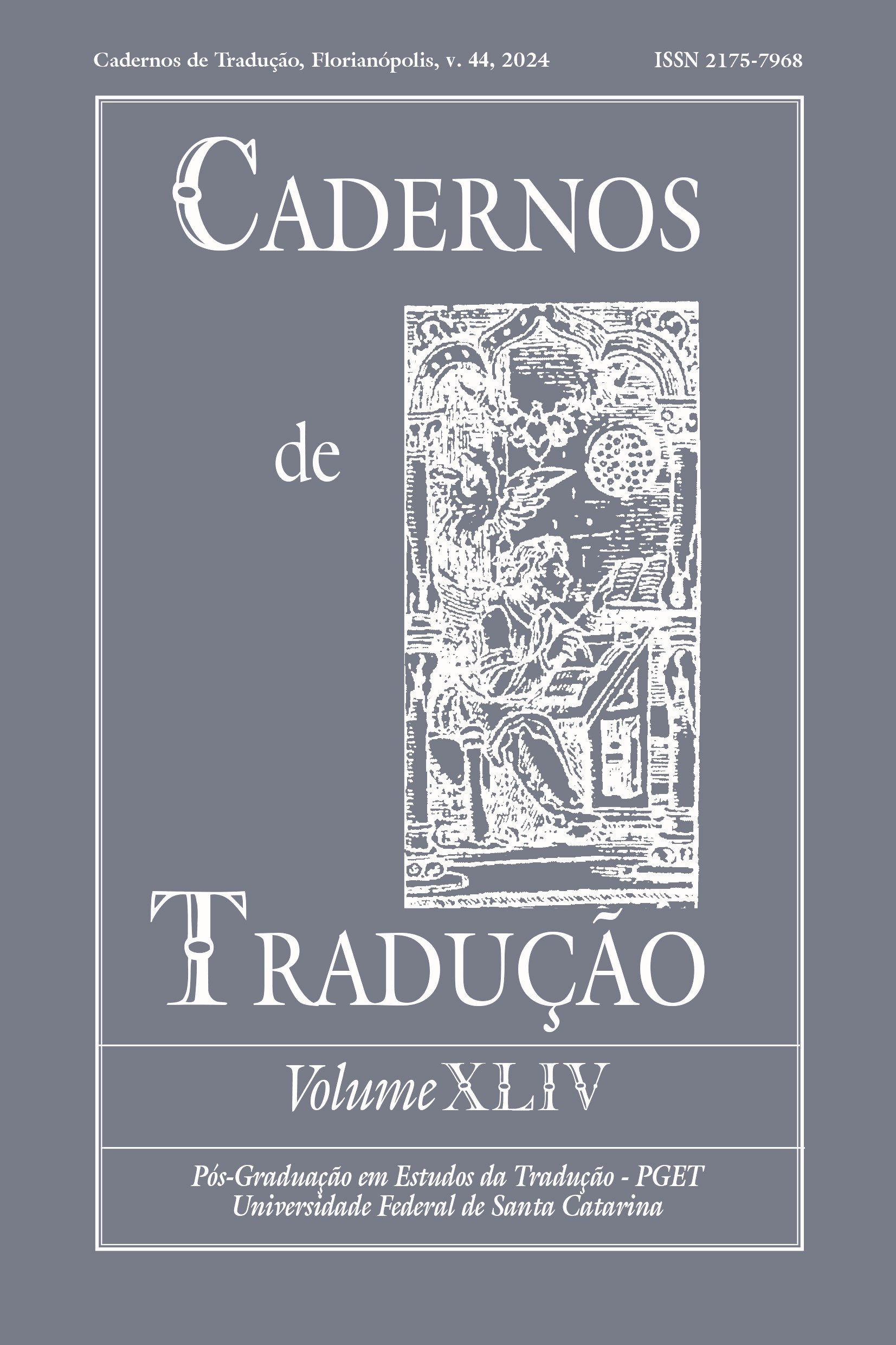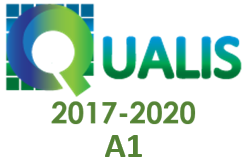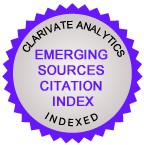Analysis of the translator’s style based on the translation of The Analects from Chinese into Spanish
DOI:
https://doi.org/10.5007/2175-7968.2024.e97379Keywords:
The Analects, translator’s style, corpus study, Chinese, SpanishAbstract
This study examines and contrasts two complete translations of The Analects, a Chinese philosophical book translated into Spanish. One version is by Chang Shiru, a Chinese scholar, while the other is by Joaquín Pérez Arroyo, a Spanish translator. A comparative analysis using various lexical, sentence, and discursive parameters based on a self-constructed corpus has been conducted. Furthermore, for the sake of a detailed analysis, the pronoun “yo”, the keyword “superior”, and the particle “que” have been chosen as a case study. Based on the findings, Chang demonstrates a more broad lexicon and employs less complicated sentence structures than Pérez Arroyo. On the other hand, Pérez Arroyo employs a less diverse vocabulary and constructs more sophisticated sentences. Furthermore, Pérez Arroyo tends to provide more explicit translations. Nevertheless, the preference of translators towards explicitness and simplification strategies varies depending on the intended readership. Various factors, including language anuld ctural differences between Chinese and Spanish, translators’ individual habits, the intended aim of the translation, and the translator's personal background, could impact the construction of a translator’s unique style.
References
Anónimo. (1999). Analectas: Reflexiones y enseñanza [orig. 论语]. (J. Pérez Arroyo, Trad.). Círculo de Lectores.
Anónimo. (2009). Analectas de Confucio [orig. 论语]. (S. Chang, Trad.). Casa Editorial de Enseñanza e Investigación de las Lenguas Extranjeras.
Anónimo. (2020). Analectas. (S. Chang, Trad.). Herder Editorial.
Anthony, L. (2023). AntConc (Version 4.2.4) [Computer Software]. Waseda University.
Baker, M. (1993). Corpus linguistic and translation studies: Implications and applications. In M. Baker, G. Francis & E. Tognini-Bonelli (Eds.), Text and Technology: In Honour of John Sinclair (pp. 233–250). John Benjamins.
Baker, M. (1995). Corpora in translation studies: An overview and some suggestions for future research. Target: International Journal of Translation Studies, 7(2), 223–243. https://doi.org/10.1075/target.7.2.03bak
Baker, M. (1996). Corpus-based translation studies: The challenges that lie ahead. In H. Somers (Ed.), Terminology, LSP and Translation: Studies in Language Engineering in Honour of Juan C. Sager (pp. 175–186). John Benjamins.
Baker, M. (2000). Towards a methodology for investigating the style of a literary translator. Target: International Journal of Translation Studies, 12(2), 241–266. https://doi.org/10.1075/target.12.2.04bak
Becher, V. (2011). When and why do translators add connectives? A corpus-based study. Target: International Journal of Translation Studies, 23(1), 26–47. https://doi.org/10.1075/target.23.1.02bec
Bergeton, U. (2019). Found (and lost?) in translation: Culture in The Analects. Harvard Journal of Asiatic Studies, 79(1–2), 49–95. https://doi.org/10.1353/jas.2019.0004
Blum-Kulka, S. (1986). Shifts of cohesion and coherence in translation. In J. House & S. Blum-Kulka (Eds.), Interlingual and Intercultural Communication (pp. 17–35). Gunter Narr.
Chen, G. (2010). On the philosophy of Roger Ames’s translation of the analects. Contemporary Chinese Thought, 41(3), 64–76. https://doi.org/10.2753/CSP1097-1467410305
Chen, H. (2015). On Matteo Ricci’s interpretations of Chinese culture. Coolabah, (16), 87–100.
Fernández, L. G. (2001). «Yo soy, pues saberlo quieres...»: La tarjeta de presentación del demonio en el Códice de autos viejos y en la comedia nueva. Criticón, (83), 105–114.
Figueroa Lackington, B. A. (2021). El Xué Ér en el horizonte conceptual confuciano. Estudios de Asia y África, 56(1), 75–94. https://doi.org/10.24201/eaa.v56i1.2506
Grabowski, L. (2013). Interfacing corpus linguistics and computational stylistics: Translation universals in translational literary Polish. International Journal of Corpus Linguistics, 18(2), 254–280. https://doi.org/10.1075/ijcl.18.2.04gra
Gumul, E. (2006). Explicitation in simultaneous interpreting: A strategy or a by-product of language mediation? Across Languages and Cultures, 7(2), 171–190. https://doi.org/10.1556/Acr.7.2006.2.2
He, M. (2017). A comparative multidimensional study of the English translation of Lunyu (The Analects): A corpus-based study. Journal of Language Studies, 17(3), 37–54. https://doi.org/10.17576/gema-2017-1703-03
Hermans, T. (1996). The translator’s voice in translated narrative. Target: International Journal of Translation Studies, 8(1), 23–48. https://doi.org/10.1075/target.8.1.03her
Huang, L. (2008). Explicitation of personal pronoun subjects in English-Chinese translation: A corpus-based investigation. Foreign Language Teaching and Research, 40(6), 454–481.
Huang, L. (2011). Bilingual parallel corpus-based studies of translational style: From the perspectives of shifts of personal pronoun subjects and narrative point of views. Foreign Languages in China, 8(6), 100–106.
Ke, F. (2005). The explicitation and implicitation of translation. Foreign Language Teaching and Research, 4, 303–307.
Lai, K. (2008). An Introduction to Chinese Philosophy. Cambridge University Press.
Liu, Y., & Tor-Carroggio, I. (2022). Audio description translation: A pilot study in Chinese/Spanish. In C. Taylor & E. Perego (Eds.), The Routledge Handbook of Audio Description (pp. 460–475). Routledge.
Liu, Z. (2023). A corpus-based study on the Spanish translation of 道 (dao) in The Analects. CLINA Revista Interdisciplinaria de Traducción Interpretación y Comunicación Intercultural, 8(2), 135–161. https://doi.org/10.14201/clina202282135161
Liu, Z, & Sun, C. (2024, en prensa). Direction of translation and textual cohesion: A study of two Spanish translations of The Analects using Coh-Metrix-Esp. Círculo de Lingüística Aplicada a La Comunicación.
Mahlberg, M., & McIntyre, D. (2011). A case for corpus stylistics: Ian Fleming’s Casino Royale. English Text Construction, 204–227. https://doi.org/10.1075/etc.4.2.03mah
Marco, J. (2012). An analysis of explicitation in the covalt corpus: The case of the substituting pronoun one(s) and its translation into Catalan. Across Languages and Cultures, 13(2), 229–246. https://doi.org/10.1556/Acr.13.2012.2.6
Matten, M. A. (2004). Hermeneutics of translation: A critical consideration of the term dao in two renderings of The Analects. Journal of Chinese Philosophy, 31(3), 329–347. https://doi.org/10.1111/j.1540-6253.2004.00157.x
Min, F. (2021). Understanding and translating Confucian philosophy in The Analects: A sociosemiotic perspective. Semiotica, (239), 287–306. https://doi.org/10.1515/sem-2017-0144
Munday, J. (2013). Style and Ideology in Translation. Routledge.
Olohan, M. (2002). Leave it out! Using a comparable corpus to investigate aspects of explicitation in translation. Cadernos de Tradução, 1(9).
Paiva, P. T. P. (2007). Estudo de traços de simplificação e explicitação em artigos científicos de anestesiologia. Cadernos de Tradução, 2(20).
Pan, W. (2004). Translating into out of one’s mother tongue: On the feasibility of translating Chinese classics into English by native Chinese translators. Chinese Translators Journal, 25(2), 42–45.
Pang, X. (2015). Unifying vs. Diversifying approaches and relevant reflection on translation of cultural keywords: Based on the case analysis of Junzi and its counterpart Xiaoren. Linguistics and Literature Studies, 3(4), 169–178. https://doi.org/10.13189/lls.2015.030405
Perego, E. (2003). Evidence of explicitation in subtitling: Towards a categorisation. Across Languages and Cultures, 4(1), 63–88. https://doi.org/10.1556/Acr.4.2003.1.4
Real Academia Española. (2010). Nueva gramática de la lengua española manual. Espasa.
RStudio Team. (2022). Rstudio: Integrated Development Environment for R [Manual].
Saldanha, G. (2011). Translator style: Methodological considerations. The Translator, 17(1), 25–50. https://doi.org/10.1080/13556509.2011.10799478
Scott, M. (2004). The WordSmith tools (v. 4.0). Oxford University Press.
Scott, M., & Tribble, C. (2006). Textual Patterns: Key Words and Corpus Analysis in Language Education. John Benjamins.
Tao, Y. (2018). From monologue to dialogue: Western translators’ perspective on translating key cultural concepts in The Analects. Translation Review, 102(1), 1–21. https://doi.org/10.1080/07374836.2018.1515682
Toury, G. (1995). Descriptive Translation Studies and Beyond. John Benjamins.
Vermeer, H. J. (2012). Skopos and commission in translational action. (A. Chesterman, Trad.). In L. Venuti (Ed.), The Translation Studies Reader (3rd ed., pp. 191–202). Routledge.
Vinay, J.-P., & Darbelnet, J. (1995). Comparative Stylistics of French and English: A methodology for translation (J. C. Sager & M. J. Hamel, Trads.). John Benjamins.
Wang, Q., & Li, D. (2011). Looking for translator’s fingerprints: A corpus-based study on Chinese translations of Ulysses. Literary and Linguistic Computing, 27(1), 81–93. https://doi.org/10.1093/llc/fqr039
Winfield, B. H., Mizuno, T., & Beaudoin, C. E. (2000). Confucianism, collectivism and constitutions: Press systems in China and Japan. Communication Law and Policy, 5(3), 323–347. https://doi.org/10.1207/S15326926CLP0503_2
Winters, M. (2009). Modal particles explained: How modal particles creep into translations and reveal translators’ styles. Target: International Journal of Translation Studies, 21(1), 74–97. https://doi.org/10.1075/target.21.1.04win
Xiao, R. (2010). How different is translated Chinese from native Chinese?: A corpus-based study of translation universals. International Journal of Corpus Linguistics, 15(1), 5–35. https://doi.org/10.1075/ijcl.15.1.01xia
Xu, X. (2014). The analysis of different translations of The Analects by James Legge and Ku Hung-Ming from perspective of Hermeneutics. Studies in Literature and Language, 9(1), 149–154. http://dx.doi.org/10.3968/n
Yang, B. J. (2015/1980). Translation and Annotation of the Analects [Lunyu Yizhu]. Zhonghua Book Company.
Yang, L., & Zhou, G. (2022). A semantic similarity analysis of multiple English translations of The Analects: Based on a natural language processing algorithm. Frontiers in Psychology, 13. https://doi.org/10.3389/fpsyg.2022.992890
Zhang, R. (2018). La traducción del “Tao” (道) en dos versiones del “Lunyu” (論語). Encuentros en Catay, 57–80.
Zhang, X., Kotze, H., & Fang, J. (2020). Explicitation in children’s literature translated from English to Chinese: A corpus-based study of personal pronouns. Perspectives: Studies in Translation Theory and Practice, 28(5), 717–736. https://doi.org/10.1080/0907676X.2019.1689276
Zhang, Y., & Chen, M. (2023). Research on the foreign translation and dissemination of chinese canonical books: Taking 30 years of research on the foreign translation and dissemination of the Classical Chinese Library as an example. View on Publishing, 22, 57–64. https://doi.org/10.16491/j.cnki.cn45-1216/g2.2023.22.009
Zheng, Y. (2013). Análisis de la interpretación de “Ren” en la traducción de Lunyu (Analectas de Confucio). Estudios de Traducción, 3, 203–211. https://doi.org/10.5209/rev_estr.2013.v3.41999
Zufferey, S., & Cartoni, B. (2014). A multifactorial analysis of explicitation in translation. Target: International Journal of Translation Studies, 26(3), 361–384. https://doi.org/10.1075/target.26.3.02zuf
Downloads
Published
How to Cite
Issue
Section
License
Copyright (c) 2024 Cadernos de Tradução

This work is licensed under a Creative Commons Attribution 4.0 International License.
Copyright Notice
Authors hold the copyright and grant the journal the right for their articles' first publication, being their works simultaneously licensed under the Creative Commons Attribution License (CC BY), which allows the sharing of such works with its authorship acknowledged and its initial publication in this journal.
Authors are allowed to enter into separate additional contractual arrangements for the non-exclusive distribution of the journal's published version of the work (e.g., post it to an institutional repository or as a book chapter, with an acknowledgment of its initial publication in this journal).






















































